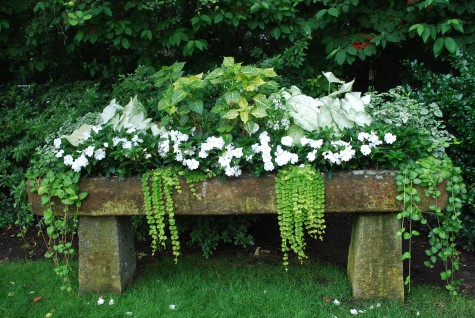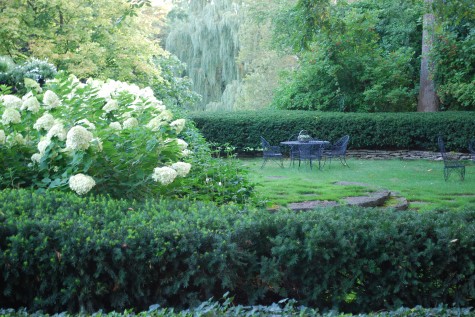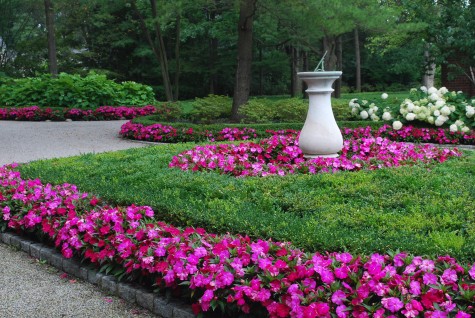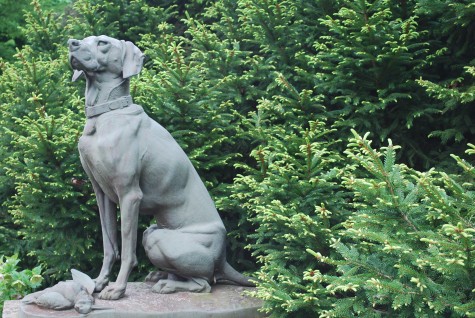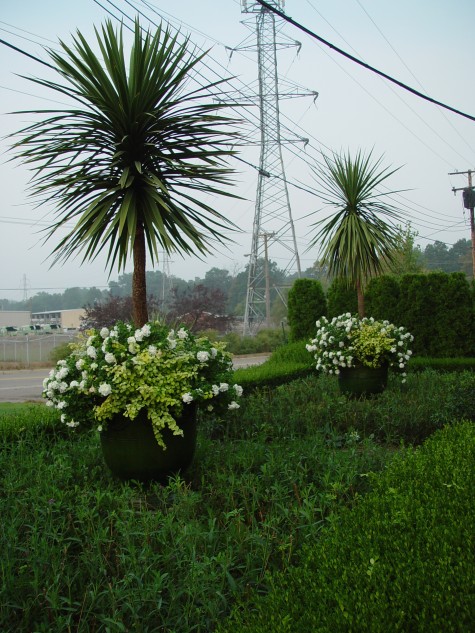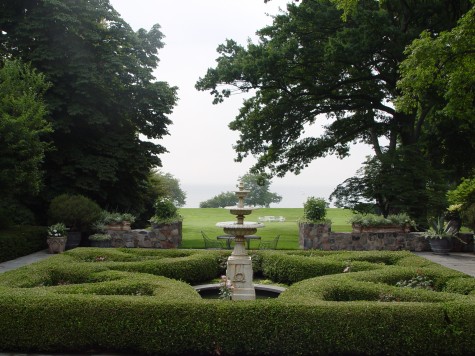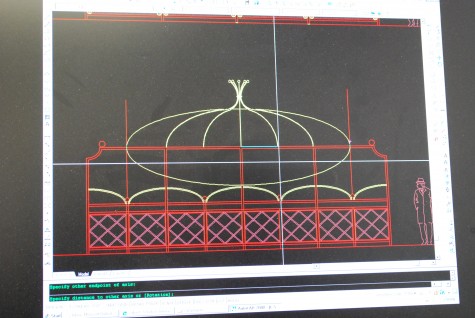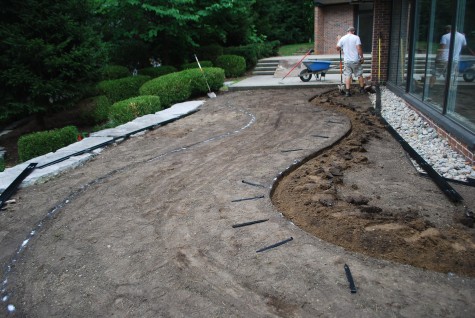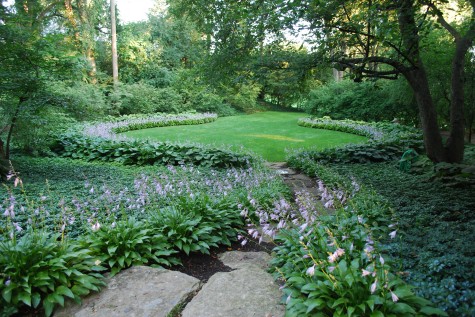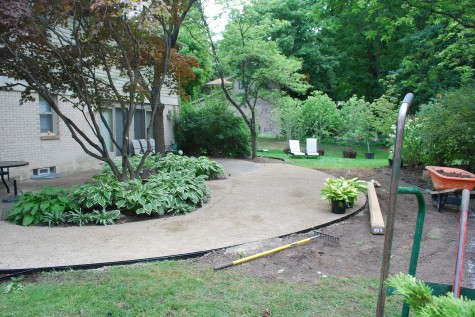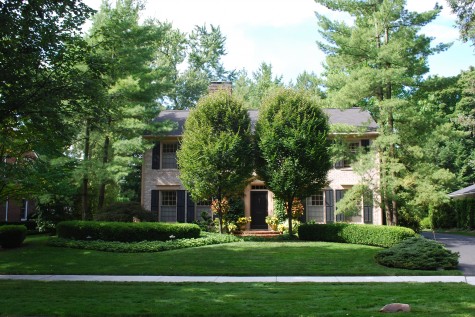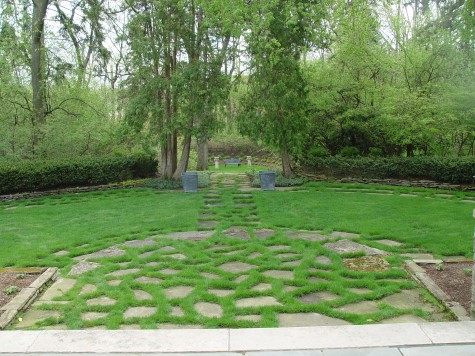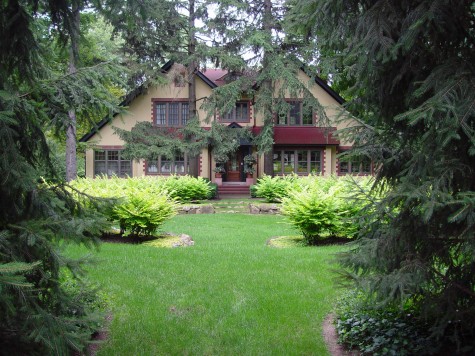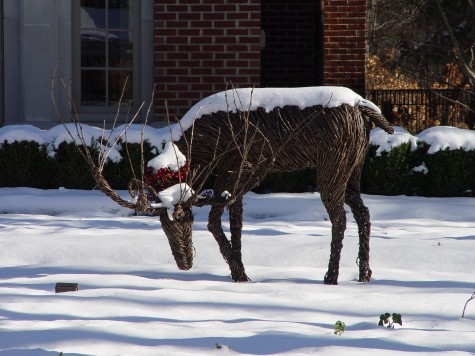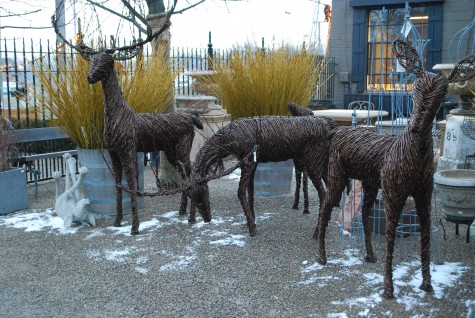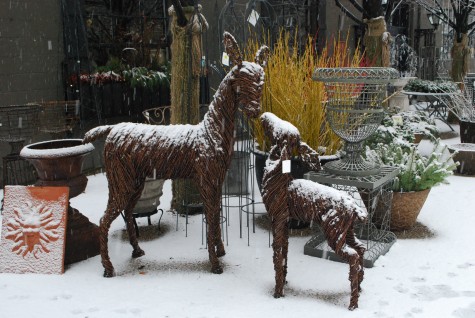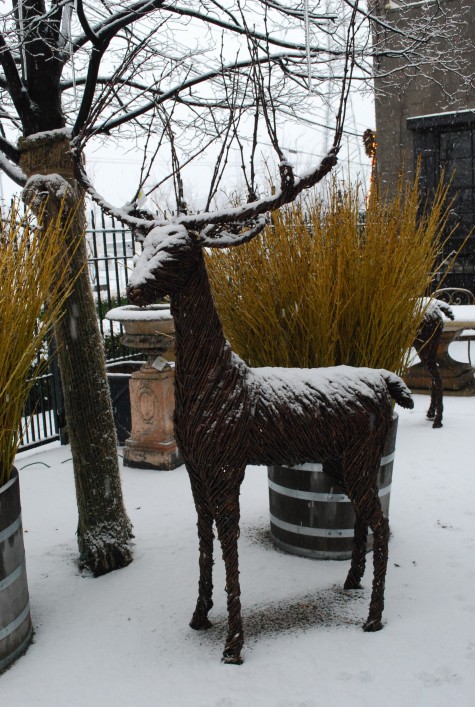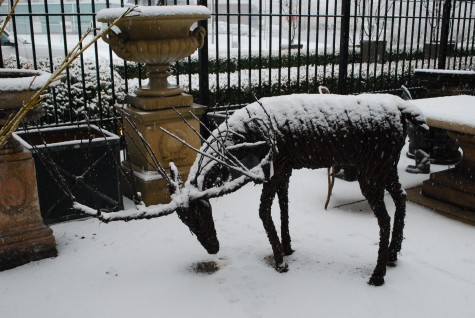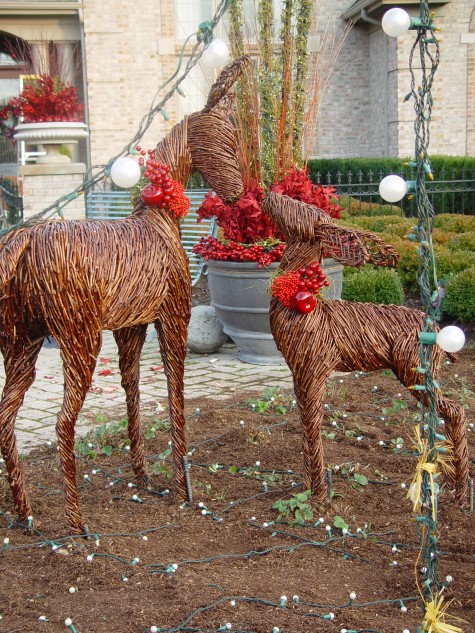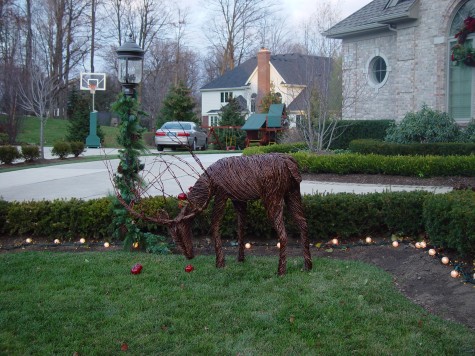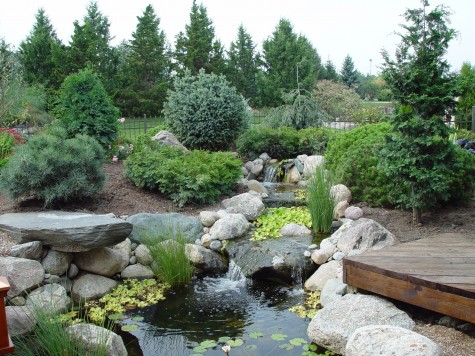 I made my first visit to this garden in 2006. My clients-serious gardeners. Ray is first and foremost a rock lover. He collects little rocks, big rocks, boulders-like I said, he loves rocks. He built a waterfall and pools in their backyard-I was impressed by his efforts. Janice-she is a committed science teacher, and horticulturally adept. She is a player. The two of them asked me to intervene in their efforts. In 2007, I planted a group of dwarf conifers for them.
I made my first visit to this garden in 2006. My clients-serious gardeners. Ray is first and foremost a rock lover. He collects little rocks, big rocks, boulders-like I said, he loves rocks. He built a waterfall and pools in their backyard-I was impressed by his efforts. Janice-she is a committed science teacher, and horticulturally adept. She is a player. The two of them asked me to intervene in their efforts. In 2007, I planted a group of dwarf conifers for them.
 The pond bridge, the waterfall, the pools,the deck, and the perimeter plantings were largely in place when I got there. I assembled a group of dwarf evergreens I thought would soften Ray’s rocks, and provide year round interest. They live in a neighborhood; the views to the neighbors-not so good. They needed a landscape that addressed their sophisticated tastes in plants, that also screened out untoward views. A private garden oriented around interesting and unusual plants.
The pond bridge, the waterfall, the pools,the deck, and the perimeter plantings were largely in place when I got there. I assembled a group of dwarf evergreens I thought would soften Ray’s rocks, and provide year round interest. They live in a neighborhood; the views to the neighbors-not so good. They needed a landscape that addressed their sophisticated tastes in plants, that also screened out untoward views. A private garden oriented around interesting and unusual plants.
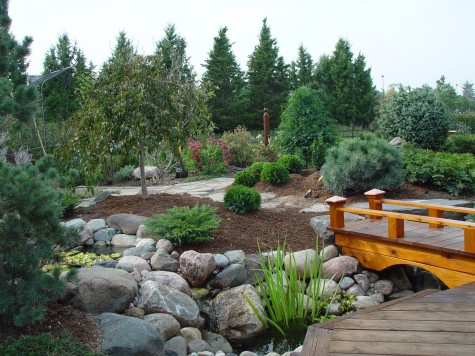 Proper planting means big spaces in between. Dwarf conifers grow slowly, but they grow. Some so called dwarf confiers actually attain considerable size when they age. I am by no means an expert on the topic, so I studied up on those evergreens that interested me in terms of shape or needle texture or color. A few key or central plants, and a supporting cast for each. The first year-there is lots of bark in evidence.
Proper planting means big spaces in between. Dwarf conifers grow slowly, but they grow. Some so called dwarf confiers actually attain considerable size when they age. I am by no means an expert on the topic, so I studied up on those evergreens that interested me in terms of shape or needle texture or color. A few key or central plants, and a supporting cast for each. The first year-there is lots of bark in evidence.
 My visit today, some three years later-a different story. They are great gardeners-every conifer has grown, and looks healthy. I could barely believe I was visiting the same garden. Dwarf evergreens of contrasting forms, colors and textures had covered the ground. It may be tough to spot, but my arrangement of dwarf conifers took into account a view of a blue spruce on a community berm at a distance. Blue evergreens-they look their best far away. Study this picture. That blue spruce far away adds visual depth to what is a small garden. Placing blue needled evergreens far and away adds great depth to a landscape. Though this spruce does not belong to them, it is part of their garden view.
My visit today, some three years later-a different story. They are great gardeners-every conifer has grown, and looks healthy. I could barely believe I was visiting the same garden. Dwarf evergreens of contrasting forms, colors and textures had covered the ground. It may be tough to spot, but my arrangement of dwarf conifers took into account a view of a blue spruce on a community berm at a distance. Blue evergreens-they look their best far away. Study this picture. That blue spruce far away adds visual depth to what is a small garden. Placing blue needled evergreens far and away adds great depth to a landscape. Though this spruce does not belong to them, it is part of their garden view.
 The varying textures and colors of greens are very pleasing to the eye. I would imagine this garden is lovely with a dusting of snow, or on a rainy day. The best part of evergreen plants is how weather changes their appearance. No doubt there will be some sort of weather, every day. Planning a landscape to take advantage of all of the seasons is worth the challenge. A good landscape design takes the predictable growing, the weather, and the unexpected issues into account, and still reads strongly. How this garden looks today pleases me.
The varying textures and colors of greens are very pleasing to the eye. I would imagine this garden is lovely with a dusting of snow, or on a rainy day. The best part of evergreen plants is how weather changes their appearance. No doubt there will be some sort of weather, every day. Planning a landscape to take advantage of all of the seasons is worth the challenge. A good landscape design takes the predictable growing, the weather, and the unexpected issues into account, and still reads strongly. How this garden looks today pleases me.
 Ray’s bridge has settled down-it reads as part of a whole now, given its green company. Goldfish swarm the pool. There is a water lily blooming. Most everything I planted is growing vigorously.-no garden is without loss and disappointment. These clients have an oasis of their own making. They have done all the work of the watering, the pruning, the feeding, the nurturing-the fussing about. I spent two days there. They have done four years worth of work.
Ray’s bridge has settled down-it reads as part of a whole now, given its green company. Goldfish swarm the pool. There is a water lily blooming. Most everything I planted is growing vigorously.-no garden is without loss and disappointment. These clients have an oasis of their own making. They have done all the work of the watering, the pruning, the feeding, the nurturing-the fussing about. I spent two days there. They have done four years worth of work.
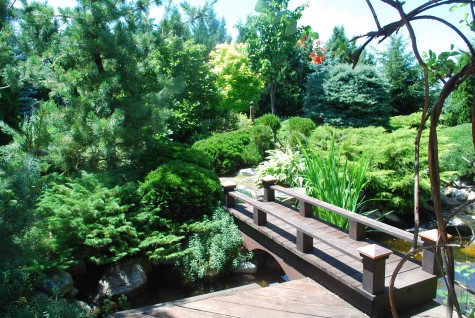 I do not mind visiting some projects, years later, with enchantment on my mind. My favorite clients-those gardeners that scoop up the idea and the installation-and go on from there. How I admire those clients who understand what it means to take up the reins, and go on. A Princeton Gold maple planted outside the fence, and as far away as possible, lights up the foreground planting. It was mrecilessly hot and sunny yesterday, but the look here is lush and refreshing.
I do not mind visiting some projects, years later, with enchantment on my mind. My favorite clients-those gardeners that scoop up the idea and the installation-and go on from there. How I admire those clients who understand what it means to take up the reins, and go on. A Princeton Gold maple planted outside the fence, and as far away as possible, lights up the foreground planting. It was mrecilessly hot and sunny yesterday, but the look here is lush and refreshing.
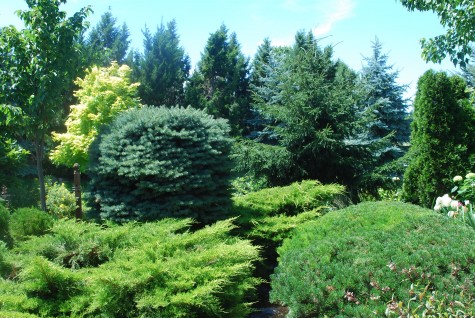 This conifer garden-I would have it. They have looked after it in such a way that they deserve a prize. I do my share of the work-but a committed steward is everything to a garden. Some days I would just as soon give away my garden as have it. Then I have lucky days. Yesterday Buck accidentally locked himself out of the house an hour before I got home. All the watering chores got done. I was only adrift for one second- I got in the fountain, and had a glass of wine.
This conifer garden-I would have it. They have looked after it in such a way that they deserve a prize. I do my share of the work-but a committed steward is everything to a garden. Some days I would just as soon give away my garden as have it. Then I have lucky days. Yesterday Buck accidentally locked himself out of the house an hour before I got home. All the watering chores got done. I was only adrift for one second- I got in the fountain, and had a glass of wine.
Their garden-beautiful. I love going back, and seeing a project that has no further need of me.

